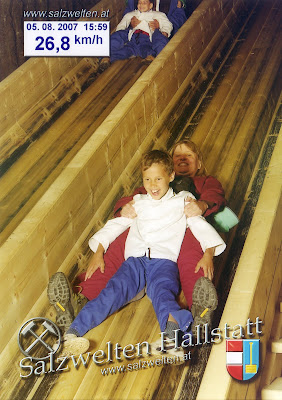We gave the kids a break from churches and castles and drove to Hallstatt which is an hour away from Salzburg. Here we visited the Ice Caves, the Bone House and the Salt Mine.
There is indication of settlement in the Hallstatt which dates back to the Stone Age. Stone axes from 5,000 BC have been found in the area which serve as proof of salt mining in prehistoric times.
The Hallstatt Salt Mine is over 7,000 years old and is the oldest salt mine in the world. The world uses around 150 million tonnes of salt each year and the Hallstatt salt mine produces over 900 million kg of salt per year.
We rode in a funicular up the mountain and then walked the rest of the way (15 minutes) to the mine entrance. Where the funicular stops on the mountain is where the miners used to live
We rode in a funicular up the mountain and then walked the rest of the way (15 minutes) to the mine entrance. Where the funicular stops on the mountain is where the miners used to live
Before we went on our tour we dressed in miner's clothes.
This is the Christina mine entrance and is 928 metres above sea level.
In 1734 a corpse was discovered preserved in a salt deposit. It was described as "pressed flat and tightly grown into the rock. Clothing and tools were quite strange but well preserved."
The highlight of the tour was a ride on the 64 metre slide which was used by the miners to descend quickly from one level to another.
We used the train to leave the mine in the same way that as the miners.
We left the salt mine and then went to Hallstein Ice Caves. At the start of the century Peter Gamsjager was out tracking down a runaway goat and he discovered the ice cave. Tours of the cave began in 1910 and the funicular was completed in 1951. After the funicular ride there is a steep 15 - 20 minute walk to the entrance. For the boys the time was mainly spent waiting for us to catch up to them.
a.jpg)
The total length of the cave is 2,700 metres but we only went along an 800 metre path. The tour lasted an hour and the temperature in the cave is -1 degrees all year round.
John preparing himself for our caving expedition.
.JPG)
The ice cave contains 30,000 square metres of ice which is up to 25 metres thick. There is seepage into the cave via the snow melting and the air flows into the cave in winter and out of the cave in summer.
a.jpg)
.jpg)
.JPG)
We enjoyed our tour of the cave but it was nice to get out into the warm sun.

.jpg)
a.jpg)
.JPG)


.JPG)
a.jpg)
a.jpg)